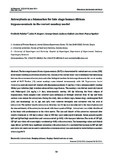| dc.contributor.author | Maloba, Fredrick | |
| dc.contributor.author | Kagira, John M | |
| dc.contributor.author | Gitau, George | |
| dc.contributor.author | Ombui, Jackson | |
| dc.contributor.author | Hau, Jan | |
| dc.contributor.author | Ngotho, Maina | |
| dc.date.accessioned | 2013-06-13T11:41:35Z | |
| dc.date.available | 2013-06-13T11:41:35Z | |
| dc.date.issued | 2011 | |
| dc.identifier.citation | Fredrick Maloba, John M. Kagira, George Gitau, Jackson Ombui, Jan Hau, Maina Ngotho (2011). Astrocytosis as a biomarker for late stage human African trypanosomiasis in the vervet monkey model. Sci ParasitoI12(2):53-59, June 2011 | en |
| dc.identifier.uri | http://erepository.uonbi.ac.ke:8080/xmlui/handle/123456789/32996 | |
| dc.description.abstract | The late stage human African trypanosomiasis (HAT) is characterized by central nervous system (CNS) involvement resulting in activation of astrocytes. The aim of the current study was to determine the relationship between the occurrence of astrocytosis and other biological markers for late stage disease in the vervet monkey model of HAT. Twelve (12) vervet monkeys were infected intravenously with 104 Trypanosoma brucei rhodesiense, and sub-curatively treated with diminazene aceturate (5 mg/kg x 3 days, intramuscularly) starting 28 days post infection (dpi) to induce advanced late stage disease. The monkeys were further curatively treated with Melarsoprol (3.6 mg/kg x 4 days, intravenously) starting 140 dpi following the blood relapse of trypanosomes. Brain samples were collected upon euthanasia at fortnight intervals from 42 dpi and brain sections were stained for astrocytosis. During the study, data on clinical signs, haematology, cerebrospinal fluid (CSF) and immunology (IL-I0, IgG, and IgM) were collected fortnightly and correlated with the level of astrocytosis. The earliest time for astrocytosis detection was 42 dpi, in areas adjacent to the choroid plexus and the size and density of the astrocytes increased with time to peak at 98 dpi. Astrocytosis was widely distributed in the brain with predominance in the white matter. The size and density of the astrocytes regressed after curative treatment at 140 dpi to almost clear at 300 days post melarsoprol treatment. Serum parasite specific IgM and IgG had high sensitivities and were associated (p<0.05) with time post infection. The levels of CSF IgG, CSF IgM and white cell counts highly correlated (p<0.05) with astrocytosis. The haematology values and clinical signs did not (p>0.05) have significant correlation with astrocytosis. It is concluded that increase in CSF IgG, IgM and white cell counts can be used to indicate the occurrence astrocytosis and should be tested further as markers oflate stage HAT. | en |
| dc.language.iso | en | en |
| dc.title | Astrocytosis as a biomarker for late stage human African trypanosomiasis in the vervet monkey model | en |
| dc.type | Article | en |
| local.publisher | Department of Public Health, Pharmacology and Toxicology, University of Nairobi, Kenya. | en |

